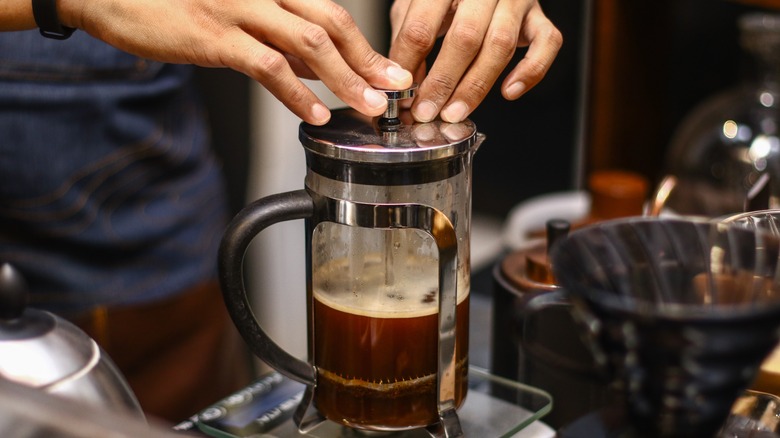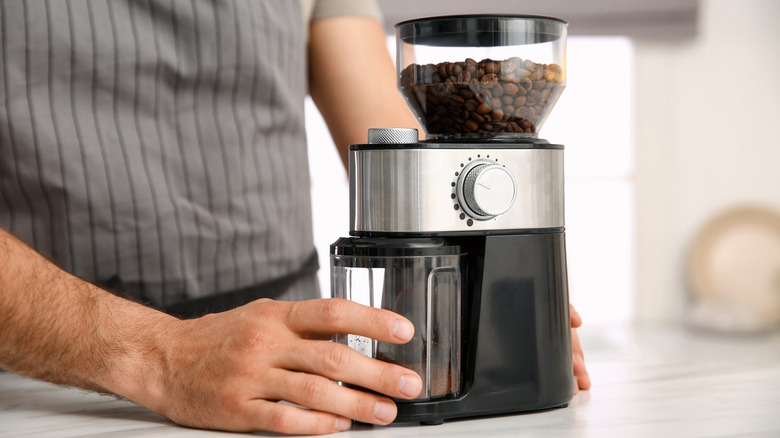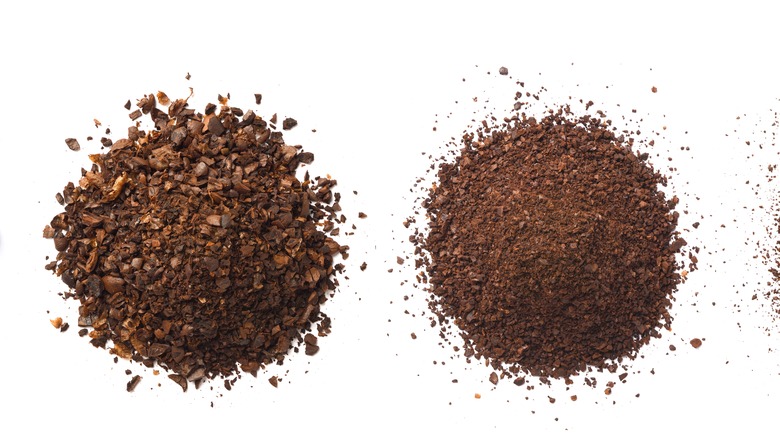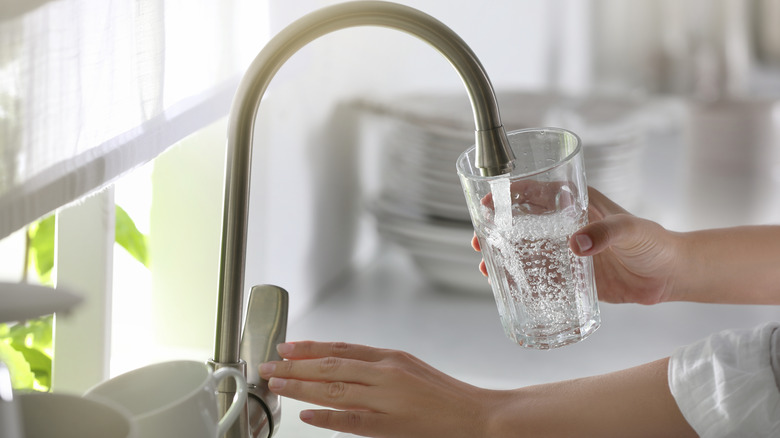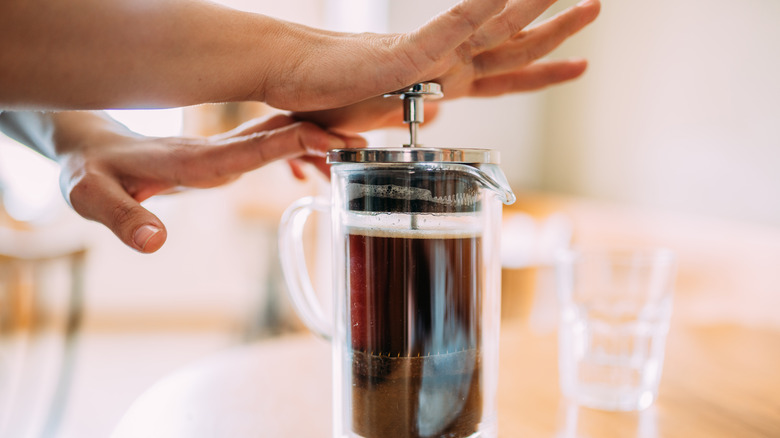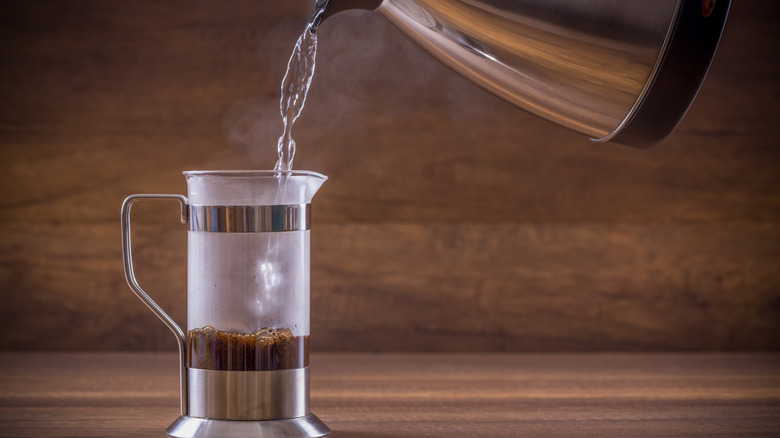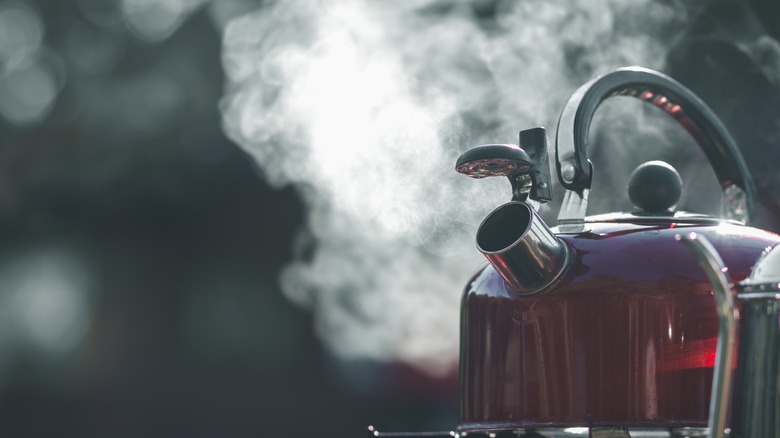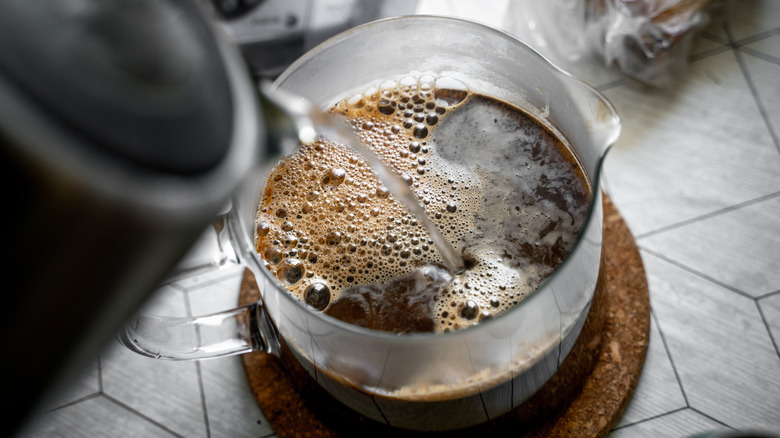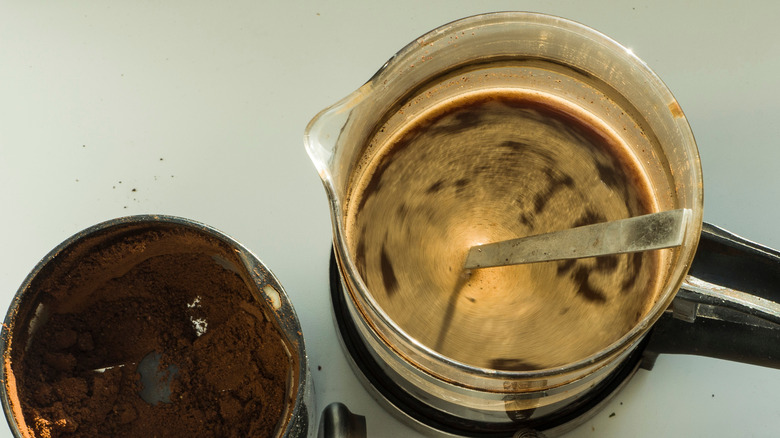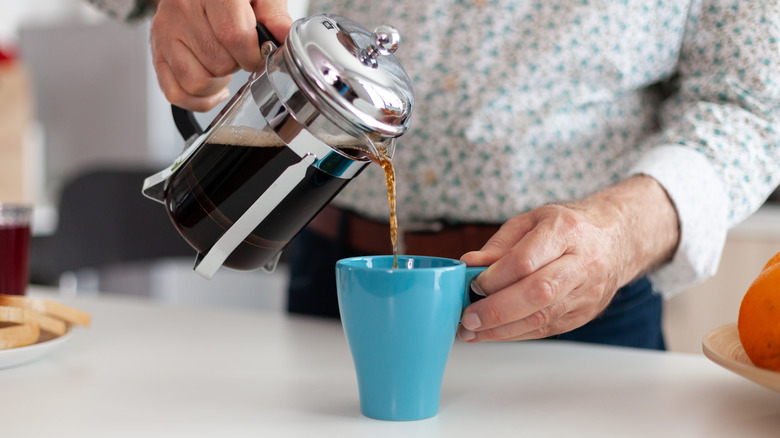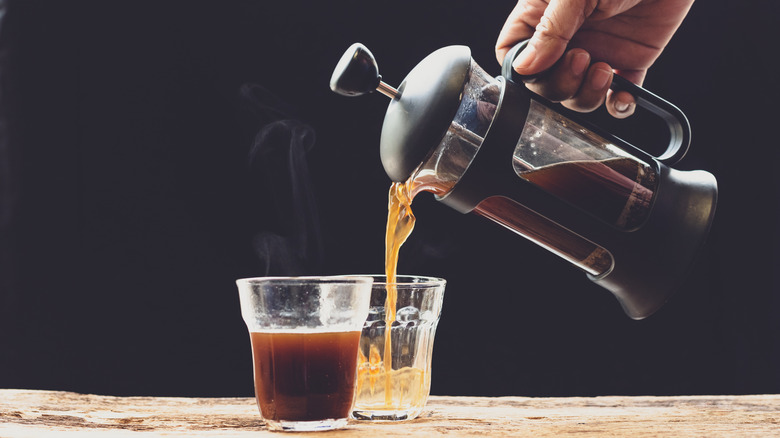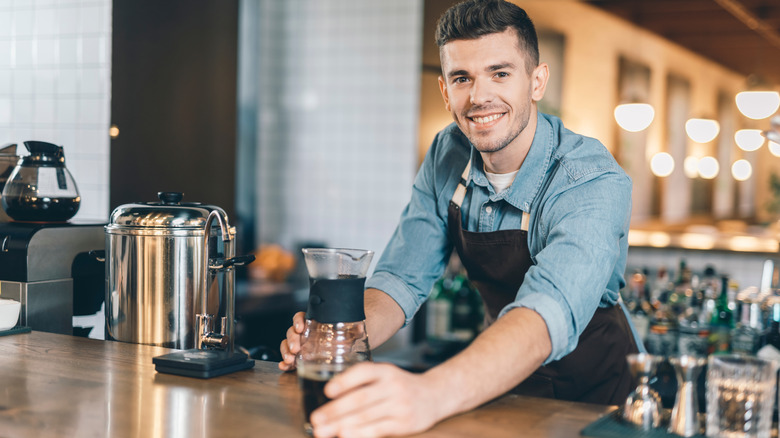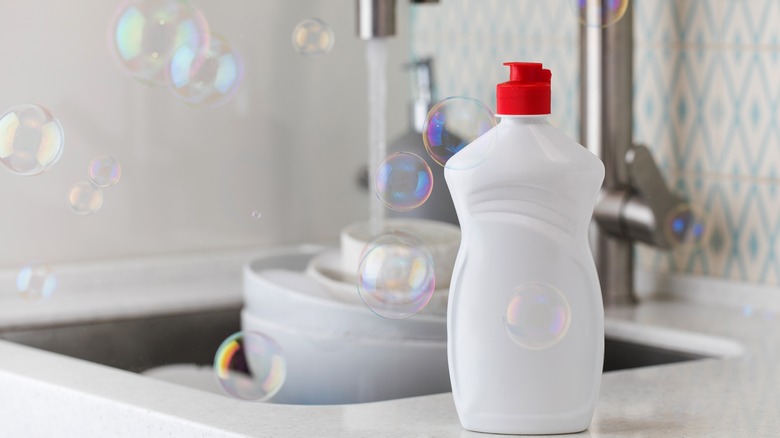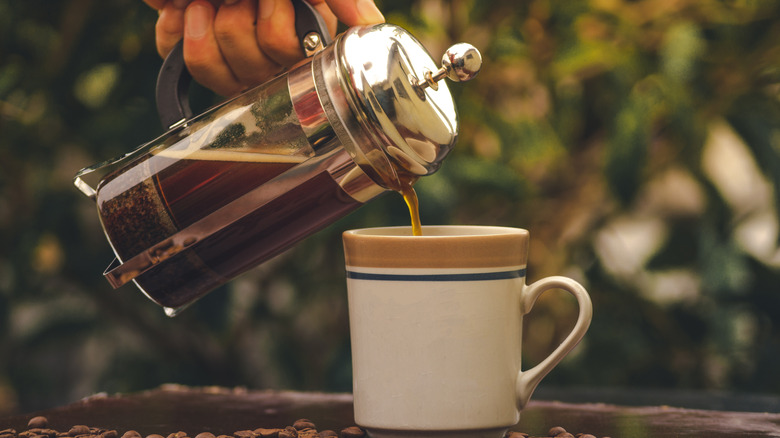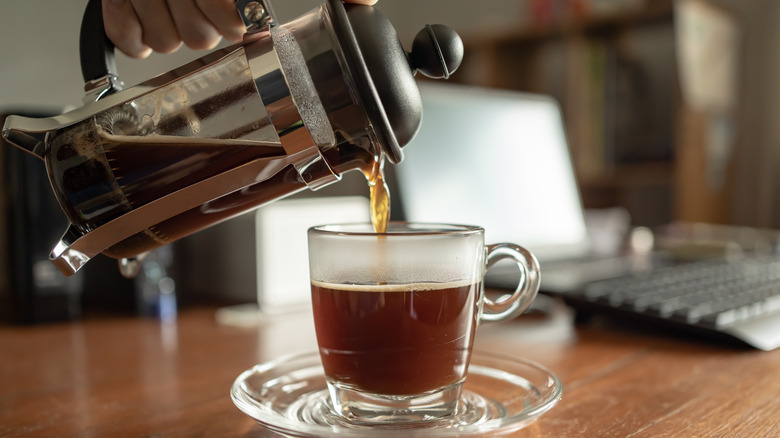14 Steps You Need When Brewing French Press Coffee
When any old cup of coffee won't cut it, you owe it to yourself to invest in a French press. It's not only affordable, but it is one of the best ways to ensure you fully enjoy the taste of your coffee. Sure, drip coffee makers are faster, and Keurig brews are more convenient, but the French press provides you with an intimate, personal connection with your brew. It gives you a hands-on approach from start to finish. From grinding down the beans all the way to timing out the steep and pouring that deliciously aromatic liquid into an eagerly awaiting cup, you have direct control over everything. Of course, that means your coffee's eventual outcome, for better or worse, will completely hinge on your actions throughout the brewing process. Whether you have been experimenting with a French press for some time now and the taste just isn't where you want it to be, or you're ready to up your at-home coffee game, here are tips you absolutely need to follow when it comes to making the ultimate cup of French press coffee.
Always grind your own beans
We get it. Pre-ground coffee is easier. You open the bag, scoop out the coffee, and dump it into the filter (or in this case, the press). But the French press isn't about making things faster. It's about making things better. And coffee beans will always deliver a better, fresher cup of coffee. If you're going to purchase pre-ground coffee you might as well just pull the Mr. Coffee drip machine out of storage.
While some pre-ground coffee does come in vacuum-sealed containers, the majority have "smell-here" holes, which do allow some airflow. In other words, as soon as coffee beans are ground, freshness begins to leave them like a leaky faucet. Thankfully, a French press, tea kettle, and coffee grinder together generally cost less than a decent drip coffee maker, all while giving you far more control over the quality of the coffee you make.
If you don't want to wake up family members in the morning when you're preparing for work, there is a workaround. You can grind the coffee you need the night before, put it in a Ziploc bag, and place the bag in the refrigerator. That way, your freshly ground coffee is there, waiting for you, when you wake up.
Coarse ground coffee
Believe it or not, the grind size of your beans is very important to the overall quality of your coffee. When it comes to using a French press you want a coarser grind. A coarse grind is somewhere between 0.75 mm and 1 mm.
So why does the size of your grind even matter? It's all the coffee beans, isn't it? Well, yes and no. When you are using a very fine coarse, it will expel its flavor into the water faster than a coarse grind. This means the cup of coffee will be brewed faster. Sounds good, right? Well, with a French press, you need some time to let everything steep and settle. A fine coarse won't allow you that time, which can result in an acidic-tasting cup of coffee. Additionally, you're not working with a paper filter. You have metal mesh in the press. A finer grind will leak through the mesh and into your cup of coffee. A few coffee grinds are natural, but if you need a toothpick following a cup of coffee, it means the grinds are far too small.
Tap water might be best
Some coffee shops will use filtered and distilled water. This ensures a more consistent taste, especially between coffee shop locations. It is a great option for chain restaurants looking for a consistent taste. But you're not a coffee chain. You're making coffee inside your kitchen, and you're looking for the best possible taste. Yes, filtered and distilled water will give you a clean, consistent taste, and yet sometimes that actually doesn't deliver the best taste. In fact, your tap water might actually enhance the flavor of your coffee. This is because minerals often found in tap water, such as magnesium and calcium, can improve the overall quality of your brew. It's worth having your water tested (you can purchase a water testing kit online or from most home improvement stores), just so you know the makeup of your water.
Of course, there's nothing wrong with a little bit of experimentation. You can use your current tap water for a batch of coffee, and you can use distilled water. You might find you like the distilled coffee, or you may find it has a bit of a flat taste. It's a personal preference worth testing out.
How much coffee to add to your French press?
Ultimately you will need to experiment a bit with this to find out just how strong or weak you want your coffee. Some coffee drinkers love a deep, dark, strong cup of coffee, while for others a cup of coffee in the morning is more about the experience rather than the taste, in which case something on the lighter side is perfectly fine. Which boat are you in?
Thankfully, if you want something a bit more concrete to follow, instead of just guessing aimlessly — because for some reason brewing the perfect cup of coffee was never taught in high school — we've got you covered. A good rule of thumb is to shoot for around 1 gram of coffee per 15 grams of water (which is equal to about three tablespoons of coffee for every cup of water). This is 1 gram of grounded coffee, so when spooning out the full beans into your grinder, go a little over.
Pre-heat the French press
Don't just let the glass of your French press sit around as you boil water in a tea kettle. Add hot water to the French press as you wait for the boil. This will help preheat the glass, which in turn keeps your coffee hot as the glass has already heated up.
Timing is very important when it comes to making coffee with a French press. The more precise you are with your timing, the better the results for your cup of coffee will be. Eventually, you will pour the previously boiling water into the press. However, your press is glass and, as you know by putting your hand onto a cold window during the winter, glass isn't exactly the best material for retaining heat. In order words, you will lose heat through the glass while the coffee steeps. Pre-heating your French press helps prevent this. So let that hot water from the tap sit in the press while your kettle works itself up to a boiling point. You will have less heat loss when it comes to adding the grinds and the boiling water if you do.
Let the boiled water sit
It's early in the morning and you already want to inject that caffeine directly into your veins. We feel your pain. But French press coffee is as much art as it is science, and to get the best flavor out of your coffee, you will want to allow the boiled tea kettle water to sit a minute or so before pouring it into the press.
Boiling point, if we're using good ol' Fahrenheit, is 212 degrees (or 100 degrees Celsius). However, the desired temperature for adding water to coffee is 195 degrees Fahrenheit. So, you will need to let the water cool momentarily. That 17-degree temperature drop will not take long, so letting it cool for a minute should give you ample time. If you want to check, feel free to use a meat thermometer. Or, better yet, if you have an electric kettle that allows you to specifically set the temperature, you can simply grab and pour once it hits 195 degrees.
Activate (or bloom) your coffee grounds
You're so close to that delicious cup of coffee, and yet yes, we are telling you to wait a little longer. The anticipation is good for you (and the coffee)! Trust us.
You want to activate your coffee grounds, which is also known as letting it bloom. This means you will add in about twice as much water as you have coffee grinds without fully filling up the press with water. This will help open the grounds up and allow them to begin releasing their delicious goodness. If you are a whiskey drinker, you likely already know about adding a drop or two of distilled water into the drink, which helps open up and activate the whiskey. In many ways, this is something similar. The coffee grinds will begin to activate and start to release its internal deliciousness. You don't need a full press of water to do this. You can let the coffee activate for 30 seconds or so as you proceed to the next step.
Stir your coffee
As the coffee grinds begin to release their caffeinated heaven into the water, gently stir the mixture to ensure the grinds are evenly spread out. It also helps prevent clumping, which can stunt some of the grinds from their full releasing potential. We recommend using a clean, wooden spoon. Don't have a wooden spoon that will fit? Not a problem, you can use the handle of any wooden utensil you have.
Do be careful with how you stir French press coffee though. It doesn't need to be an aggressive stir or a fast one. Just a few quick swirls with the wooden spoon and everything will be fine. Once you have stirred the coffee, the grinds should be fully activated, and you can add in the rest of the water, which you withheld during the previous step. Don't worry. You are always done with the brewing process and are only a few minutes away from finally sipping on a perfectly brewed cup of coffee.
Know the brewing time
If you're someone who has been letting your grinds steep for the amount of time it takes for you to complete some chores around the house, you're not alone. Truth be told it is something we were once culprits of doing. It's so easy to do. Pour the hot water into the French press, go fold the laundry, come back, and the coffee is ready. Well, while you're able to do that, it doesn't result in a good-tasting cup of coffee. In fact, it ends up turning your cup into something stomach-churning (literally).
The longer your coffee grinds sit in the water, the greater the chance of you sipping on an acidic cup of Joe. You might not have tasted the strong acidity of the coffee (especially if you add cream, sugar, cinnamon, and whatever other flavorings you like), but if your stomach felt a little off following the cup, it's likely because of the high acidic level in the coffee. Thankfully, you can avoid all of this if you stick to a very set brewing time. Just four minutes is ideal. Set your timer to four minutes as soon as you add the initial water to help bloom the grinds. By the time the timer hits four minutes, you're ready to pour. We suggest pouring all the coffee into a decanter, and then from the decanter into your mug — but if you want to go the other way around, that's fine too.
Don't over steep
The amount of time you steep your coffee grinds is especially important. This is directly connected with the previous step in knowing how long you need to brew your French press coffee. Too short and you're short-changing yourself important flavor, leaving you with a watery, weak cup of coffee. Leave it in too long and you're going to have an acidic mess on your hands (which you're stomach isn't going to like either).
In general, you'll want to start the timer when you fill the French press with water initially (as in when you are activating the coffee, not when you fill it up to the top). Four minutes is the sweet spot, but it is okay if you go over slightly. Really anywhere between four minutes and five minutes and you should be fine. There might be some slight variance based on the kind of coffee you are using and if there is any kind of flavored coating pre-applied to the coffee, such as hazelnut or pumpkin spice, which can slow down some of the activation. However, regardless of the grind or flavor of coffee bean you are using, if you let the coffee steep for longer than five minutes you are running the risk of pouring out a less-than-desirable final product, which would be a shame as you've worked so hard to have the perfect cup of coffee.
Decanter your extra coffee
Okay, so you have that first cup of coffee poured right at four minutes. Fantastic. But what are you supposed to do with the coffee that is still in the press? Unless you have three or four friends over with their cups extended toward you, there will be coffee sitting with the grinds. This coffee will only continue to steep, which is going to result in an inferior cup, should you need a refill. A third cup will nearly be undrinkable (if you're really paying attention to the flavor and you take it black). This is where you need to invest in a coffee decanter. It's not all that different from a wine decanter. Many of these look like sand dials, and it's a good way to separate the coffee from the grinds. We recommend looking for decanters that come with an extra fine mesh or air-tight seal that helps block the grinds out from falling into the decanter.
Clean your French press
It goes without saying (but we're saying it anyway), you need to clean the French press after every use. And don't just rinse it out, assuming it is fine because you'll be using it again the next day. You need to fully wash and rinse it. Take extra care and focus on the mesh within the French press handle. Coffee grinds can easily become stuck within the mesh. Much like food debris stuck between your teeth, if the grinds are not removed, they will sit and fester, which in turn will interfere with the rest of your future brews.
Of course, you need to thoroughly rinse the French press and mesh out once you're done washing it. Don't want to have any soap scum taste in your morning coffee the next day. This taste is very evident, should it ever happen. We would recommend washing it by hand and not relying on the dishwasher. It's easier to get into all the crevices, not to mention you can wash it out right after you're done with it. By the time you return home from work, it'll be dry and ready to go (just in case you need a second batch for late-night work calling your name).
Know what is causing problems with your coffee
Because there are more variables at play with your French press coffee, there are more potential outcomes with your coffee. You need to know what is causing the taste variations and how you can correct them.
If your coffee is on the bitter or even sour side it is because your grinds are too fine. When the grinds are fine the flavors are released too quickly, which affects your steeping time. It's a domino effect that results in that bitter taste. If your coffee grinds are fine but the problem persists, you need to now check your brew time. Make sure you hit that four-minute mark.
Also, don't worry if you have a few grinds in your cup of coffee. That happens with the French press. But if it bothers you, pour the entire French press contents into a decanter first, and then pour your first cup of coffee. The extra filtration will help prevent this.
Don't rush it
One of the most important tips you can follow is to never rush your French press coffee. A delicious cup of coffee takes time. If you wanted something quick and effortless you'd use a different method. With a French press, it is as much about the experience of brewing the coffee as it is drinking it. So make sure you take your time and enjoy the journey of crafting the ultimate cup of coffee. And with this method of brewing coffee, you are always able to tweak how you make your coffee. Whether you want it stronger or weaker, you want to experiment with the kind of water you use, or you want to remove the acidity within your coffee that other brewing methods result in, turning to the French press is your answer. There are books about experiencing zen in the art of making tea. In many ways, you can experience your own morning zen when making coffee using a French press. So relax, take a deep breath, and enjoy your zen journey toward the perfect cup of coffee.
